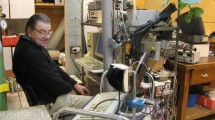Abstract
Two species-invariant tryptophan residues at positions 109 and 250 of tobacco Rubisco activase were identified by site-directed mutagenesis as being responsible for the increase in intrinsic fluorescence upon addition of ATP, which has been previously attributed to increased self-association. Substitution of W109, which is immediately prior to a ‘P-loop’ sequence in the ATP catalytic motif, with aromatic residues (Tyr or Phe), Cys or Lys eliminated both ATP hydrolysis and the intrinsic fluorescence enhancement. Although the W109 mutants bound ATP, ATP did not provide a partial protection against proteolysis by trypsin that was observed with the recombinant wild-type enzyme. In contrast, substitution of W250 with Tyr or Phe abolished about half (44%) of the increase in intrinsic fluorescence with ATP, but had little effect on ATP hydrolysis, ribulose-1,5-bisphosphate carboxylase/oxygenase (Rubisco) activation or proteolytic protection with ATP. The substitution of the other tryptophan residues, W16 and W305, with phenylalanine did not significantly alter the change in intrinsic fluorescence upon addition of ATP. Therefore, W109 and W250 are the residues reporting the conformational change that increases the intrinsic fluorescence.
Similar content being viewed by others
Abbreviations
- ANS:
-
1-anilinonaphthalene-8-sulfonic acid
- Rubisco:
-
ribulose-1,5-bisphosphate carboxylase/oxygenase
- RuBP:
-
d-ribulose-1,5-bisphosphate
- AAA+ :
-
super family of ATPases associated with diverse cellular activities
References
Brand L, Gohlke JR, (1972) Fluorescence probes for structure Ann Rev Biochem 41: 808–866
Crafts-Brandner SJ, van de Loo FJ, Salvucci ME, (1997) The two forms of ribulose-1,5-bisphosphate carboxylase/oxygenase activase differ in sensitivity to elevated temperature. Plant Physiol 114: 439–444
Esau B, Snyder GW, Portis AR, Jr (1996) Differential effects of N- and C-terminal deletions on the two activities of rubisco activase Arch Biochem Biophy 326: 100–105
Kallis RP, Ewy RG, Portis AR Jr (2000) Alteration of the adenine nucleotide response and increased Rubisco activation activity of Arabidopsis Rubisco activase by site-directed mutagenesis Plant Physiol 123: 1077–1086
Lee CS, O’Sullivan WJ, (1985) The interaction of phosphorothioate analogues of ATP with phosphomevalonate kinase. Kinetic and 31P NMR studies J Biol Chem 260:13909–13915
Li C, Salvucci ME, Portis AR, Jr, (2005) Two residues of Rubisco activase involved in recognition of the Rubisco substrate J Biol Chem 280: 24864–24869
Lilley RM, Portis AR, Jr, (1997) ATP hydrolysis activity and polymerization state of ribulose-1,5-bisphosphate carboxylase oxygenase activase : Do the effects of Mg2+, K+, and activase concentrations indicate a functional similarity to actin? Plant Physiol 114: 605–613
McAlear MA, Howell EA, Espenshade KK, Holm C, (1994) Proliferating cell nuclear antigen (pol30) mutations suppress cdc44 mutations and identify potential regions of interaction between the two encoded proteins Mol Cell Biol 14: 4390–4397
Neuwald AF, Aravind L, Spouge JL, Koonin EV, (1999) AAA+: A class of chaperone-like ATPases associated with the assembly, operation, and disassembly of protein complexes Genome Res 9: 27–43
Ogura T, Wilkinson AJ, (2001) AAA+ superfamily ATPases: common structure - diverse function Genes Cells 6: 575–597
Pecoraro VL, Hermes JD, Cleland WW, (1984) Stability constants of Mg2+ and Cd2+ complexes of adenine nucleotides and thionucleotides and rate constants for formation and dissociation of MgATP and MgADP Biochemistry 23: 5262–5271
Portis AR, Jr, (2001) The Rubisco activase-Rubisco system: an ATPase-dependent association that regulates photosynthesis. In: McManus MT, Laing WL, Allen AC, (Eds) Protein–Protein Interactions in Plant Biology. Sheffield Academic Press, Sheffield, England, 30–52
Portis AR, Jr, (2003) Rubisco activase–Rubisco’s catalytic chaperone Photosynth Res 75: 11–27
Robinson SP, Portis AR, Jr, (1989) Adenosine triphosphate hydrolysis by purified Rubisco activase Arch Biochem Biophy 268: 93–99
Salvucci ME, (1992) Subunit interactions of Rubisco activase: polyethylene glycol promotes self-association, stimulates ATPase and activation activities, and enhances interactions with Rubisco Arch Biochem Biophys 298: 688–696
Salvucci ME, Klein RR, (1994) Site-directed mutagenesis of a reactive lysyl residue (Lys-247) of Rubisco activase Arch Biochem Biophys 314: 178–185
Shen JB, Orozco EM, Ogren WL, (1991) Expression of the two isoforms of spinach ribulose 1,5-bisphosphate carboxylase activase and essentiality of the conserved lysine in the consensus nucleotide-binding domain J Biol Chem 266: 8963–8968
Shen JB, Ogren WL, (1992) Alteration of spinach ribulose-1,5-bisphosphate carboxylase/oxygenase activase activities by site-directed mutagenesis Plant Physiol 99: 1201–1207
Smith CK, Baker TA, Sauer RT, (1999) Lon and Clp family proteases and chaperones share homologous substrate-recognition domains Proc Natl Acad Sci USA 96: 6678–6682
van de Loo FJ, Salvucci ME, (1996) Activation of ribulose-1,5-bisphosphate carboxylase/oxygenase (Rubisco) involves Rubisco activase Trp16 Biochemistry 35: 8143–8148
van de Loo FJ, Salvucci ME, (1998) Involvement of two aspartate residues of Rubisco activase in coordination of the ATP γ -phosphate and subunit cooperativity Biochemistry 37: 4621–4625
Walker JE, Saraste M, Runswick MJ, Gay NJ, (1982) Distantly related sequences in the a- and b-subunits of ATP synthase, myosin, kinases and other ATP-requiring enzymes and a common nucleotide binding fold EMBO J 1: 945–951
Wang ZY, Portis AR, Jr, (1991) A fluorometric study with 1-anilinonaphthalene-8-sulfonic acid (ANS) of the interactions of ATP and ADP with rubisco activase Biochim Biophys Acta 1079: 263–267
Wang ZY, Portis AR, Jr, (1992) Dissociation of ribulose-1,5-bisphosphate bound to ribulose-1,5-bisphosphate carboxylase oxygenase and its enhancement by ribulose-1,5-bisphosphate carboxylase oxygenase activase-mediated hydrolysis of ATP Plant Physiol 99: 1348–1353
Wang ZY, Ramage RT, Portis AR, Jr, (1993) Mg2+ and ATP or adenosine 5′-[γ-thio]-triphosphate (ATPγS) enhances intrinsic fluorescence and induces aggregation which increases the activity of spinach Rubisco activase Biochim Biophys Acta 1202: 47–55
Zhang N, Portis AR, Jr, (1999) Mechanism of light regulation of Rubisco: A specific role for the larger Rubisco activase isoform involving reductive activation by thioredoxin-f Proc Natl Acad Sci USA 96: 9438–9443
Acknowledgement
This work was supported in part by a Grant (97ER20268) from the US Department of Energy.
Author information
Authors and Affiliations
Corresponding author
Rights and permissions
About this article
Cite this article
Wang, D., Portis , A.R. Two conserved tryptophan residues are responsible for intrinsic fluorescence enhancement in Rubisco activase upon ATP binding. Photosynth Res 88, 185–193 (2006). https://doi.org/10.1007/s11120-006-9051-2
Received:
Accepted:
Published:
Issue Date:
DOI: https://doi.org/10.1007/s11120-006-9051-2




